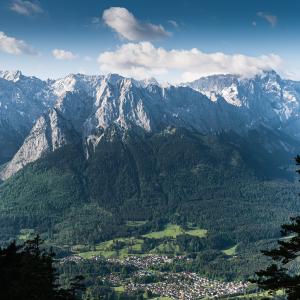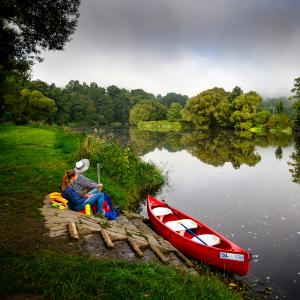The UNESCO World Cultural Heritage sites in Bavaria
They are excellent witnesses of times past, and they uphold Bavarian traditions to this very day: the fourteen UNESCO World Cultural Heritage sites originate from the times of the Romans, the Romanesque period, the Gothic period and the Rococo period and are, to this very day, among Bavaria's most popular destinations.
- Water management in Augsburg
- The spa town of Bad Kissingen
- The old town of Bamberg
- Frontiers of the Roman Empire: the Danube limes
- The Margravial Opera House in Bayreuth
- Frontiers of the Roman Empire: the Upper Germanic-Rhaetian limes
- Prehistoric pile dwellings around the Alps
- The old town of Regensburg with Stadtamhof
- The Residence in Würzburg
- The Wieskirche at Steingaden
- Neuschwanstein Castle
- Herrenchiemsee Palace
- Linderhof Palace
- King’s House on Schachen
Water management in Augsburg
With its magnificent fountains, its many canals and historic water towers, Augsburg was added to the coveted UNESCO list in July 2019. The fountains, canals and hydroelectric power stations bear witness to man's inventiveness and his pioneering engineering skills. If your customers want to find out more about the system, the theme tour 'Water in the City' provides information.
The spa town of Bad Kissingen
Everything is opulent, lavish and pre-eminent in Europe's health resorts. Stucco, marble and velvet wherever the eye cares to roam. The country's first graduation tower was erected in Bad Kissingen in 1526. And with a length of more than 90 metres, the pump room is the largest in Europe. Your customers can still bathe here today in the splendid Luitpoldbad, built in 1868.
The old town of Bamberg
The neatly decorated town hall, the old town with its half-timbered buildings and arched bridges and, last but not least, the tranquil canals: this town in Upper Franconia, with its Romanesque Imperial Cathedral, has been on the list of UNESCO World Cultural Heritage sites since as long ago as 1993. Most of the buildings survived the Second World War and now form a listed ensemble between mediaeval and baroque architecture. Anyone who would like to know more about that should go to the World Heritage Visitors' Centre in the old town, where everything is explained in detail.
Frontiers of the Roman Empire: the Danube limes
For almost half a millennium, the Danube formed the frontier of the Roman Empire. The remains of the military installations and settlements on the western section of the Danube limes have been part of the UNESCO World Cultural Heritage since 2021. In a total of five 'Roman museums on the Bavarian Danube limes' in Kelheim, Regensburg, Straubing, Künzing and Passau, your customers can visit some impressive finds and find out more about the life of the Romans on the Danube.
The Margravial Opera House in Bayreuth
The Margravial Opera House, built in less than four years and richly gilded, is a masterpiece of baroque festival architecture and one of the best preserved royal theatres in the country. Margravine Wilhelmine von Brandenburg-Bayreuth, who was very keen on music and theatre, had it built in 1744. Today, your customers can go to the opera house for top-class music events or visit it by taking a guided tour.
Frontiers of the Roman Empire: the Upper Germanic-Rhaetian limes
At 550 kilometres, the limes is Europe's longest ground monument and forms the World Heritage site 'Frontiers of the Roman Empire'. The 'Upper Germanic-Rhaetian limes' is a section of the frontier between the Rhine and the Danube and was built starting in 120 A. D. from Bad Hönningen / Rheinbrohl on the Rhine to the fort at Eining, a Roman castra, on the Danube. It consisted of ramparts, trenches, watchtowers and forts, several of which your customers can still visit today. Or they can follow the limes on its cycle and hiking paths.
Prehistoric pile dwellings around the Alps
How did people live in the Stone and Bronze Ages (approx. 4,400 to 850 B.C.)? Why did they build wooden dwellings on stilts by lakes, rivers and moors? The sites where prehistoric pile dwellings have been found, 111 in total and spread over six states, tell of the life of the people in those times. Two of those sites are in Bavaria: Rose Island in the Starnberger See and the prehistoric settlement Pestenacker near Landsberg. Today, as museums, they give us important insights into the trade and mobility of the settlers.
The old town of Regensburg with Stadtamhof
This town, some 2000 years old, is about 100 kilometres north of Munich. In 2006, UNESCO declared the old town a World Cultural Heritage site. Well worth seeing, for example, are St. Peter's Cathedral, the Golden Tower, the Old Town Hall with the Reichssaalbau (occupied by the Imperial Diet from 1663 to 1806), St. Emmeram's Abbey and the remains of the Roman town wall. On one of three islands in the river, furthermore, lies the district of Stadtamhof, connected with the old town by the Stone Bridge. A particularly pretty feature here is the little Church of St. Mang in the Rococo style.
The Residence in Würzburg
The 580-square-metre ceiling fresco in the stairwell of the Würzburg Residence is the largest fresco worldwide, and the masterpiece of the artist Giovanni Battista Tiepolo. In the Residence, he and the architect Balthasar Neumann created a synthesis of baroque castle architecture from 1720 to 1781. Well worth seeing are also the White Hall and the Imperial Hall with their elaborate stucco work on the ceilings. Since 1981, the Residence has been part of the UNESCO World Cultural Heritage.
The Wieskirche at Steingaden
Light floods the high-ceilinged room, golden adornments glitter on the walls, the white marble effulges. The Pilgrimage Church of the Scourged Saviour at Wies rises up against the backdrop of the Ammergau Alps. It was built following a lachrymal miracle. On 14 June 1738, the peasant woman Maria Lory said she had seen tears in the eyes of a figure depicting the suffering Jesus. This occurrence was the origin of the pilgrimage to the scourged saviour in the district of Wies near Steingaden. The pilgrimage church has been part of the UNESCO World Cultural Heritage since 1983.
Neuschwanstein Castle
The castle near Füssen in the Allgäu region was added to the UNESCO World Heritage List in July 2025, together with King Ludwig II’s other royal residences. Construction began in 1869, inspired by medieval ideals, the Wartburg Castle and the operas of Richard Wagner. Neuschwanstein was designed as a private retreat. Equipped with cutting-edge technology for its time – central hot-air heating, elevators, an electric bell system and running water on every floor – Neuschwanstein Castle today stands as the very symbol of a fairy-tale palace and ranks among Europe’s most visited landmarks.
Herrenchiemsee Palace
Ludwig II began building his homage to Versailles – the “Bavarian Versailles” – in 1878, on the largest island in Lake Chiemsee. The king spent only a few days here, and the palace was never finished. The splendour unfolds in the grand staircase, the Hall of Mirrors and the Parade Bedroom, even larger and more opulent than its French equivalent. Along the main axis of the park, fountains and water features sparkle in the sun, while a museum in the south wing commemorates the “fairy-tale king”. Herrenchiemsee has been part of the UNESCO World Heritage since 2025.
Linderhof Palace
In the Ammergau Alps, an elegant palace emerged from a simple hunting lodge beginning in 1869. It was the only one of King Ludwig II’s grand building projects that he saw completed. The surrounding gardens feature ornate structures such as the Moorish Kiosk and the grand cascade with the Neptune Fountain. The highlight is the Venus Grotto – an artificial cave with a lake, waterfall and electric lighting powered by one of Bavaria’s first power plants. Linderhof Palace reflects the King’s fascination with both technology and fantasy and has been a UNESCO World Heritage Site since 2025.
King’s House on Schachen
King Ludwig II built his most secluded refuge high in the Wetterstein Mountains at an altitude of 1,866 metres. From the outside, the wooden chalet resembles a modest Alpine lodge, but the upper floor reveals oriental splendour: the Turkish Hall gleams with gilded ornaments, colourful stained-glass windows and precious carpets. Here, Ludwig celebrated his birthday each year – surrounded by a dream world far removed from reality. Since 2025, the King’s House on Schachen has been part of the UNESCO World Heritage together with the other royal palaces.



